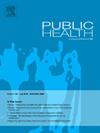Interconnectedness of exposure to community violence, maternal emotional dysfunction, and child emotional distress in Nigeria: A consideration for promoting family cohesion
IF 3.9
3区 医学
Q1 PUBLIC, ENVIRONMENTAL & OCCUPATIONAL HEALTH
引用次数: 0
Abstract
Objective
Community violence constitutes a critical public health concern with far-reaching implications for family systems. Despite its prevalence, the mechanisms through which such exposure impinges upon children's emotional well-being remain underexplored in Nigeria. This study investigates the indirect pathway from exposure to community violence to child emotional distress through maternal emotional dysfunction, and examines the moderating influence of family cohesion.
Study design
A cross-sectional survey of 304 mother-child dyads was conducted.
Methods
Data were analyzed using Partial Least Square Structural Equation Modeling (PLS-SEM) to evaluate a moderated mediation model.
Results
Exposure to community violence was significantly associated with both maternal emotional dysfunction (β = 0.242, p < 0.001) and child emotional distress (β = 0.271, p < 0.001). Maternal emotional dysfunction was a significant predictor of child emotional distress (β = 0.234, p < 0.001). Mediation analysis revealed that maternal emotional dysfunction partially mediated the relationship between exposure to community violence and child emotional distress (β = 0.057, 95 % CI [0.021, 0.097], p < 0.01). Family cohesion significantly moderated the impact of maternal emotional dysfunction on child emotional distress (β = −0.173, p < 0.01), and also buffered the direct effect of community violence on child emotional outcomes (β = −0.210, p < 0.05).
Conclusion
These findings highlight the imperatives for public health initiatives that strengthens family cohesion and provide emotional support to ameliorate the deleterious impacts of community violence on children's emotional development.
尼日利亚遭受社区暴力、母亲情绪障碍和儿童情绪困扰的相互联系:促进家庭凝聚力的考虑
目的社区暴力是一个严重的公共卫生问题,对家庭制度产生深远影响。尽管这种现象很普遍,但在尼日利亚,这种接触对儿童情感健康的影响机制仍未得到充分探讨。本研究探讨了社区暴力暴露通过母亲情绪障碍对儿童情绪困扰的间接影响,并探讨了家庭凝聚力的调节作用。研究设计对304对母子进行横断面调查。方法采用偏最小二乘结构方程模型(PLS-SEM)对数据进行分析,以评估一个有调节的中介模型。结果社区暴力暴露与母亲情绪障碍显著相关(β = 0.242, p <;0.001)和儿童情绪困扰(β = 0.271, p <;0.001)。母亲情绪障碍是儿童情绪困扰的显著预测因子(β = 0.234, p <;0.001)。中介分析显示,母亲情绪障碍在社区暴力暴露与儿童情绪困扰的关系中起部分中介作用(β = 0.057, 95% CI [0.021, 0.097], p <;0.01)。家庭凝聚力显著调节母亲情绪障碍对儿童情绪困扰的影响(β = - 0.173, p <;0.01),也缓冲了社区暴力对儿童情绪结局的直接影响(β = - 0.210, p <;0.05)。结论这些发现强调了加强家庭凝聚力和提供情感支持的公共卫生举措的必要性,以改善社区暴力对儿童情感发展的有害影响。
本文章由计算机程序翻译,如有差异,请以英文原文为准。
求助全文
约1分钟内获得全文
求助全文
来源期刊

Public Health
医学-公共卫生、环境卫生与职业卫生
CiteScore
7.60
自引率
0.00%
发文量
280
审稿时长
37 days
期刊介绍:
Public Health is an international, multidisciplinary peer-reviewed journal. It publishes original papers, reviews and short reports on all aspects of the science, philosophy, and practice of public health.
 求助内容:
求助内容: 应助结果提醒方式:
应助结果提醒方式:


